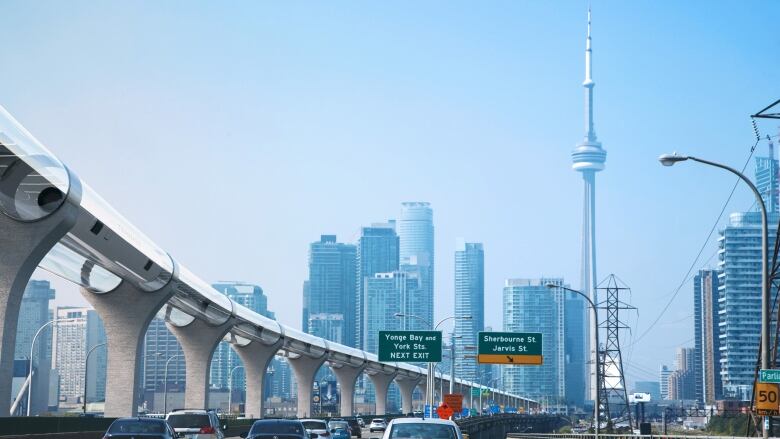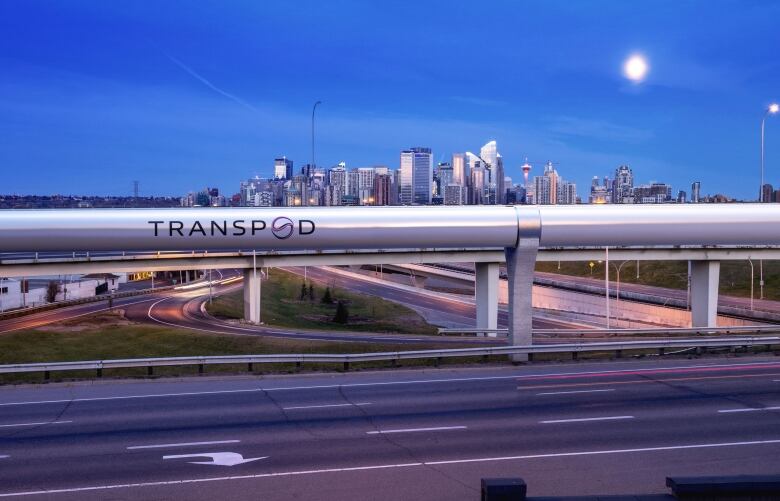Hyperloop technology will revolutionize transportation, but it has to get off the ground first
Travelling from coast to coast, at the speed of sound

Imagine travelling from Vancouver to Toronto a distance of almost 4,400 kilometres in less than three hours. Now imagine doing that without spending any more than the $12 it costs to buy a GO train ticket from Hamilton, Ont., to Toronto's Union Station.
Replace those Canadian cities with communities across the U.S., and you've got Elon Musk's vision forthe hyperloop, a vacuum tube that would be able to carry pods roughly the size of a train carriage at speeds close to the speed of sound.
The Tesla, SpaceX, and Boring Company founder has spent quite a bit of time lately speaking out and tweeting about the hyperloop.
He even confirmed that he'd received "verbal government approval" for a New York-Philadelphia-Baltimore-D.C. line, on Thursday.
Just received verbal govt approval for The Boring Company to build an underground NY-Phil-Balt-DC Hyperloop. NY-DC in 29 mins.
—@elonmuskThat poses a simple question: What's a hyperloop?
Hyper-what? Hyperloop!
As Sebastian Gendron, the co-founder and CEO of Toronto-based hyperloopstartup TransPod Inc., will attest, the idea of building something akin to a hyperloop has been around since the 1900s.
However, it wasn't really until Muskpopularized the notion in 2012 that the idea stopped being just an idea, and started becoming something almost resembling reality.
"The basic idea is to put a vehicle the size of a train coach in a vacuum tube," Gendron told CBC News.

Vacuum sealing the tube by removing all, or most, of the air removes pesky obstacles like air resistance. This means that the pods inside the tube can reach and theoretically exceed speeds of 1,000 km/h.
Unlike trains, which run on railway lines that generate friction between the carriages and the track, pods in a hyperloop would 'float' and be able to travel at much greater speeds.
Magnetic levitation (MagLev)is currently the more popular of the several levitation concepts.
MagLev works by inducing an electromagnetic field that causes objects to float using the repulsive properties of magnets. It's a phenomenon that's used in the MagLev trains in Japan and China.
In contrast to MagLev, the hyperloop idea proposed by Musk uses air bearings to produce a small amount of air to allow the passenger pods to float a little bit like a puck on an air hockey table.
If it's so great, why hasn't one been built yet?
People have been trying to build systems like the hyperloop for years.
Marcel Jufer, from the Swiss Federal Institute of Technology in Lausanne, proposed the idea of a vacuum-tube train between Bern and Zurich in the early 2000s.
But Jufer's Swissmetro idea was a bust.
"It was kind of bad timing for them," said Gendron. "They went bankrupt after the financial crisis."
The central opposition to hyperloops isn't entirely the cost of building such a system. It's convincing multiple levels of governments to back the idea, as well as convincing the public that hyperloops are safe and worth building.
Unlike trains, or even airplanes, where multiple trains can run at different speeds on a single track or even in parallel to each other hyperloop pods would travel within a vacuum tube.
That means when a pod moves in a forward direction, every pod behind it must also move in a forward direction.
One pod slowing down would mean every pod slowing down.
Gendron envisions a system that allows pods to travel as quickly as an airplane, with the frequency of a subway, but building such a system would require an enormous stretch of land, because it takes a considerable distance roughly 50 kilometres to accelerate a pod to its maximum velocity and subsequently slow down a pod to stop.
Are we going to build hyperloops or not?
Yes probably.
Companies like TransPod are already co-ordinating with different levels of government to begin implementing the necessary regulations to start building a full-fledged hyperloop.
Gendron predicts that the first commercially viable prototypes won't be unveiled until approximately 2020.
"Usually construction takes around five to seven years," he said. "And by the time the line is built, we expect the first line to be operational by 2025 and 2030."
Until then, there's a little bit of hope to be found amongst Canada's students.

Groups like the Queen's Hyperloop Design Team are already working on building their own scale models of hyperloop technology.
"One of the biggest things is you're building something new," said Arthur Cockfield, business manager for the Queen's team. "If you want to build a better train, you already know what a train looks [like], how long it'll take, and how the different parts interact with each other."
For hyperloop pioneers like Gendron and Cockfield, it's a matter of turning imagination into reality.












_(720p).jpg)


 OFFICIAL HD MUSIC VIDEO.jpg)
.jpg)



























































































